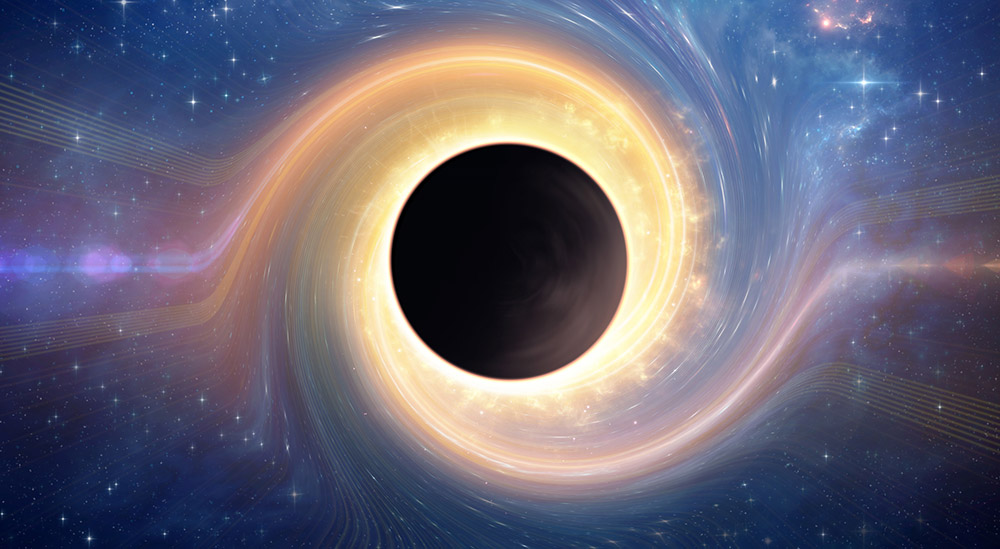Too big for models: Some black holes detected by their gravitational waves are bigger than they should be. American astrophysicists now propose a possible explanation for this – cosmic expansion. According to this, the expansion of the universe can also affect the gravity of black holes and give them more mass – without consuming additional matter. This may also explain why distant black holes appear so unexpectedly huge.
According to the current doctrine, there is a mass gap in stellar black holes: if a massive star explodes in a supernova, black holes with a maximum mass of 65 solar masses can arise. On the other hand, if the starting star is heavier than 200 solar masses, it does not explode, but collapses directly into the black hole – this has at least 120 solar masses. In the range from 65 to 120 solar masses, there is a gap in which black holes should not be – astrophysicists refer to this as a pairwise instability gap.
But in recent years, gravitational wave detectors at the LIGO and Virgo observatories have repeatedly detected the merging and mass of black holes. lies in this gap. Each of these stellar black holes weighs more than 80 solar masses – and is therefore actually very challenging for current interpretive models.
Space expansion not yet taken into account
Kevin Crocker at the University of Hawaii at Manoa and colleagues now suggest a possible explanation for this. Because, they show, an important factor when looking at black holes has been largely ignored until now: the expansion of the universe. The redshift of distant light sources and distance measurements on stars and galaxies indicate that the universe is expanding at a rate of 70 kilometers per second and parsecs – even if the exact rate of expansion is still disputed.
However, when modeling black holes and how they evolve, this factor is usually ignored. “It simplifies modeling and Einstein’s equations because there are fewer factors to consider in a non-developing universe,” Crocker explains. But in the case of distant black holes whose data we can observe are subject to cosmic expansion, their influence can certainly play a role.
cosmic conjunction
As astrophysicists explain, well-known solutions to Einstein’s general theory of relativity indicate that cosmic expansion can, under certain conditions, also lead to an increase in the mass of black holes. Interactions between the expansion of spacetime and black holes ensure that they gain mass and gravity – without the need to gobble up additional matter.
This effect may cause black holes, which were originally below the mass gap, to grow in this “exclusion zone” over longer periods of time. With the help of computer simulations, Crocker and his team have now tested whether this hypothesis is consistent with physical observations and laws. In this they followed the evolution of binary stars through their supernovae and the formation of black holes until merging.
Good compatibility with notes
The result: If you include cosmic expansion in your models, the results agree well with the LIGO observations. Primary “normal” black holes continued to evolve as the universe expanded and grew roughly synchronously with the entire universe. As a result, at the time of their merger, some stellar black holes were located in the mass gap.
“I was really surprised that it worked so well,” says co-author Gregory Tarly of the University of Michigan. “Because the idea is actually simple.” And in the future, they can be substantiated by observations, the team explains. Because this cosmic conjunction must also manifest itself in the rate at which the orbits of two massive objects become narrower over time. “Next-generation gravitational observatories can directly monitor this signature,” Crocker and colleagues said.
Explanation of huge quasars too?
Also interesting: if one thinks that the coupling of black holes with space-time is constantly further away, then this may also explain how some early supermassive black holes appeared. As the researchers calculate, it follows from the equations that the black hole that formed immediately after the Big Bang will double its mass through the expansion effect alone, so that we can see it today as a quasar at a distance of 12.5 billion light-years.
However, evidence for this pairing is still pending, Crocker and his team also acknowledge. They also assert that they have so far used only one of several conceivable astrophysical models to simulate. “So there is still some freedom and even if we see that cosmic coupling is possible, we can’t determine its strength,” says co-author Michael Zevin of the University of Chicago. (The Astrophysical Journal Letters, 2021; doi: 10.3847/2041-8213/ac2fad)
Coyle: University of Hawaii at Manoa

“Tv expert. Hardcore creator. Extreme music fan. Lifelong twitter geek. Certified travel enthusiast. Baconaholic. Pop culture nerd. Reader. Freelance student.”





More Stories
AVL and Red Bull are developing high-tech fuel cells
Munich Oktoberfest spokesman: “Cannabis simply has no place at Oktoberfest”
The new charging method could double battery life